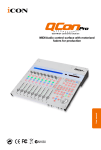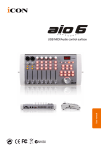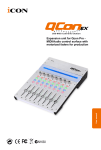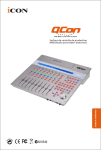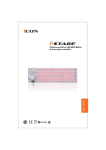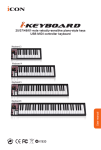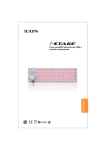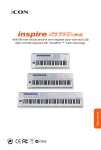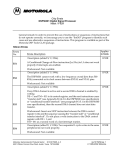Download Icon Digital QCon Lite Manual
Transcript
User manual
MIDI/Audio control surface with motorized
faders for production
N1630
Important Safety Instructions
1. Read this manual thoroughly before using this unit.
2. Keep this manual for future reference.
3. Take notice of and comply with all warnings included in the user's manual or indicated
on the appliance.
4. Follow all instructions included in this manual.
5. Do not expose this unit to rain or moisture. Avoid having water or other liquids spilled
on this unit.
6. When cleaning the cabinet or other parts of this appliance, use only a dry or slightly
damp soft cloth.
7. Do not block any ventilation openings or interfere with the proper ventilation of this unit.
Install in accordance with the manufacturer's instructions.
8. Do not use or store near any heat sources such as radiators, heat registers, stoves, or
other heat-producing appliances.
9. Do not interfere with the safety purpose of the polarized or grounding-type plug. A
polarized plug has two blades with one wider than the other. A grounding-type plug h
as two blades and a third grounding prong. These are designated for your safety. If the
provided plug does not fit into your outlet, consult an electrician.
10. Protect the power cord from being walked on or otherwise damaged by items placed
on or against them. Particular attention should be given to the plugs, receptacles, and
the point where the cord exits the appliance.
11. To avoid the risk of electrical shock, do not touch any exposed wiring while the unit is
in operation.
12. Only use attachments/accessories specified by the manufacturer.
13. Unplug this unit and all connected electrical equipment during lightning storms or when
left unused a long period of time.
14. Refer all servicing to qualified service personnel. Servicing is required when the
appliance has been damaged in any way or fails to operate normally.
WARNING: To reduce the risk of fire or electric shock, do not expose this unit to
rain or moisture
Contents
Introduction
What's in the package
1
1
Features
2
Top Panel Layout
3-5
Side Panel Layout
5
Getting Started
Connecting Your Qcon Lite Controller
6
Installing iMapTM Software for MAC OS X
7
Installing iMapTM Software for Windows
7-8
Assigning MIDI functions with iMapTM
9
iMapTM Qcon Lite software panel
9-10
Firmware upgrade
11
Restore the factory default settings
11
Connections
12
Specifications
13
Services
14
Introduction
Thank you for purchasing the ICON Qcon Lite Midi/Audio control surface. We
sincerely trust this product will provide years of satisfactory service, but if anything
is not to your complete satisfaction, we will endeavor to make things right.
In these pages, you'll find a detailed description of the features of the Qcon Lite,
as well as a guided tour through its front and side panels, step-by-step instructions
for its setup and use, and full specifications.
You'll also find a warranty card enclosed - please don't forget to fill it out and mail
it so that you can receive online technical support at: www.icon-global.com. And
so we can send you updated information about these and other ICON products in
the future. As with most electronic devices, we strongly recommend you retain
the original packaging. In the unlikely event the product must be returned for
servicing, the original packaging (or reasonable equivalent) is required.
With proper care and adequate air circulation, your Qcon Lite will operate without
any trouble for many years. We recommend that you record your serial number
in the space provided below for future reference.
Please write your serial number here for future reference:
Purchased at:
Date of purchase:
What's in the package?
Qcon Lite USB-MIDI Controller x 1pc.
Software CD / User’ Manual x 1
CD x 1
ICON Qcon Lite x 1
Quick Start Guide x 1
e
tar
uid
tG
S
ick
Qu
USB2.0 Cable x 1
QSG x 1
USB2.0 x 1
PVC overlays for different DAWs
PVC
1
Features
1x100mm touch-sensitive motorised channel/master fader
4 x dual function encoder knobs (Enter & rotate)
Large backlit LCD to display channel name, control values etc. for each channel
Jog wheel shuttle for fast search and control
Illuminated channel buttons including Rec-enable, Solo and Mute.
6 illuminated transport buttons including Play, Stop, Rec, Rewind, Fast forward
and Loop
16 illuminated function buttons.
8 illuminated assignable MIDI function buttons (F1-F8)
2 illuminated “Fader” buttons for shifting the motorised fader to different channels
2 illuminated “Bank” buttons for shifting 8 channels up or down
Extremely compact and designed to match the MacBook ProTM
Class-compliant with Windows XP, Vista (32-bit), Windows 7 (32-bit & 64-bit),
and Mac OS X (IntelMac)
USB 2.0 high speed connectivity
Mackie control build-in for Cubase, Nuendo, Samplitude, Logic Pro and Abelton Live.
Mackie HUI protocol build-in for Pro Tool.
User self-define mode (MIDI Learn) for other DAW such as Sonar.
Firmware upgrade available simply via USB connection and iMap software.
Template labels are included for difference popular DAW such as Cubase, Nuendo,
Samplitude, Logic Pro and Abelton Live .
USB bus-powered
iMapTM software included for easy mapping of MIDI functions.
Robust aluminum and metal casing with Kensington lock port
2
Top Panel Layout
Note: Function operates slightly difference between DAWs. Please refer to your DAW
manual for each function and overlap the provided labeling template according to your
current using DAW. The following description is based on the functions that operate in
Apple LogicTM.
7c
1
3
8
4a
4b
2
7a
7b
6
7c
4b
5b
1
5a
5b
LCD backlit display
The four-line backlit LCD display shows the parameter values as you adjust them
and also provides feedback about channel selections, operating modes, and more.
2
Channel/Master faders
The touch sensitive motorised fader could be used to adjust the parameter of
different channels. Press the two “Fader” shifting buttons to shift between
channels. Also, by pressing the “Master” button, the fader will turn to control
the parameter of the master channel.
Channel Fader
The 100mm motorised fader is generally used for controlling the track volume of
your DAW. Depending on your DAW, you may use the “Flip” button to switch the
function of these faders to change other settings. It is touch-sensitive to allow
override automation the moment you touch a fader. Also, it is motorised; it will
automatically move to reflect the current level of the selected channels in your
DAW application. Any automation recorded in a project will be reflected by the
fader positions. Any parameter adjustments made with these faders will be
displayed directly above on the LCD display.
Master fader
It controls your DAW software's master channel fader. Any parameter adjustments
made with this fader will be displayed directly above on the LCD display.
3
3
Dual function encoders
The dual functioned encoder acting as a push-button and a rotary control. When an
encoder is pressed, it may be used to change modes of operation or to change
what appears in the display above the channel strips. When an encoder is rotated,
depending on its assigned function, it can be used to adjust a channel's pan, send
level, or plug-in parameters.
4
Control buttons
4a) Recording channel control buttons section
REC buttons -Activate and deactivate the recording state of the associated channel.
The switch will light red when the channel is armed.
SOLO buttons -Turn On and Off the solo state of the associated channel. The
switch will light green when the channel solo state is on and other channels will
be muted.
MUTE buttons - Activate and deactivate the mute state of the associated channel.
The switch will light blue when the channel is muted.
4b) Motorized fader control buttons section
FLIP button -Press the FLIP button to swap the parameter settings of the
motorized fader and the rotary encoder knobs.
Fader < button - Shift “one” channel up for the fader.
Fader > button - Shift “one” channel down for the fader.
BANK UP button - Shift “eight” channels up for all faders (except the master channel).
BANK DOWN button - Shift “eight” channels down for all faders (except the master channel).
5
Jog wheel section
5a) Jog wheel -The jog wheel is used for various purposes specific to the DAW
application, including shuttle and scrubbing functions.
5b) Zoom control buttons section
Zoom UP/DOWN button –The Zoom UP/Down button is used to navigate up
or down through the Graphical User Interface (GUI) of the DAW application.
Zoom LEFT/RIGHT button - The LEFT/RIGHT button is used to navigate left or
right through the Graphical User Interface (GUI) of the DAW application.
Zoom IN/OUT button - Zoom in or out the track horizontally.
Zoom Track –Zoom in or out the track vertically.
6
Transport control buttons section
PLAY button -Activate the play function of the DAW.
STOP button -Activate the stop function of the DAW.
REC button -Activate the record function of the DAW.
REWIND button -Activate the rewind function of the DAW.
FAST FORWARD button - Activate the fast forward function of the DAW.
LOOP button -Activate the loop function of the DAW.
Marker button -Toggle small Marker mode.
Nudge - Toggle small Nudge mode.
Drop - Toggle Drop.
Replace - Toggle Replace.
Solo - Toggle track solo (of selected track).
4
7
Sub-control buttons
This section of control buttons varies in different DAWs. Qcon Lite is based on
LogicTM for the settings.
(Note: For different DAWs the labeling may not be perfectly matched.)
7a) Assignment section
TRACK button -Activate the track parameters of the software
PAN/SURROUND/EQ/Send/Plug-in/Instrument buttons -These buttons are used
to activate the corresponding effect function of the DAW. They are typically used
in conjunction with the rotary encoder knobs. Press the button, its light will turn
on, and then rotate the rotary encoder knob to adjust the value, which will display
on the LCD directly above.
7b) Automation section
READ button -Press the READ button to activate the read function of the current
audio track.
WRITE button -Press the WRITE button to activate the write function of the current
audio track.
7c) Modifiers-While Held Down section
SHIFT button - Switch to second function.
OPTION button - Apply function to all tracks or set parameter to minimum/maximum.
CONTROL button - Engage Group Clutch while held down.
CMD/ALT - Enable fine mode; shift parameter page by 1 parameter instead of page.
8
Display Parameters button section
NAME/VALUE button - Toggle between parameter name and parameter value display.
Side Panel Layout
1
1
USB port (B-Type)
Functions as a MIDI port to your notebook (or computer) and compatible software.
Also provides power to your Qcon Lite.
5
Getting Started
Connecting Your Qcon Lite Controller
1
Connect the Qcon Lite to your Mac/PC via the USB port.
Choose a USB port on your Mac/PC and insert the wide (flat) end of the USB
cable. Connect the cable's other end to the Qcon Lite. Your Mac/PC should
automatically “detect” the new hardware and notify you that it is ready to use.
a
b
Esc
F1
!
~
`
Tab
F2
··
1
2
Q
W
CapsLook
A
F3
F5
F4
#
3
6
5
R
F7
F6
F8
T
7
Y
D
F
G
C
V
B
F12
*
—
Z
Alt
N
M
AltGr
Del
Lns
Home
Backspace
}
[
|
]
Pgup
|
PgDN
:
>
pause
Break
=
{
P
L
<
Prtsc
sysrq
+
-
0
O
K
F11
#)
9
I
J
F10
#)
78
U
H
F9
*
%
¥
4
E
S
X
Enter
;
Shift
Ctrl
?
Ctrl
End
Shift
$
intel
Diagram 1
2
Diagram 2
Mode select & assign the MIDI messages to Qcon Lite
Select Mackie Control or HUI mode from the pull down menu for pre-mapped
MIDI mapping.
Select User Defined mode for self MIDI assignment.Refer to page.9 for “Assign
the MIDI messages with “iMapTM” software.
Tip: Make sure you have selected the correct DAW mode in the pull down menu
3
Setup your DAW
Activate the ICON Qcon Lite controller in
your DAW or MIDI software using “MIDI
Setup” or “MIDI Devices”.
iCON Qcon Lite Ver1.00
iCON Qcon Lite Ver1.00
For LogicTM, CubaseTM and NuendoTM, choose
Mackie Control at the “Device List”.
(Note: Every application does this a little
different, so refer to your software user
manual for the settings.)
6
Installing iMapTM Software for MAC OS X
Please follow the procedures below step-by-step to install your iMapTM
software to Mac OS X
1
Insert the Utility CD in your CD-Rom and double click “Qcon Lite iMap” icon.
Tips: By “drag and drop” the “Qcon Lite iMap” icon into the “Applications” folder, you
could create a “iMap” shortcut on your Mac's desktop.
Installing iMapTM Software for Windows
Please follow the procedures below step-by-step to install your iMapTM
software.
1
Turn on your PC.
2
Insert the Utility CD in your CD-Rom
After you have inserted the CD into
your CD-Rom, an installation screen
should appear as shown in diagram 1;
TM
click "iMap installation".
(Note: If the installation screen not
appear automatically go to the CD
folder and double click on "Setup")
3
Diagram 1
Setup Wizard appear
Setup wizard appears, please click
"Next"
Diagram 2
7
4
Choose Install Location
Choose your preferred install
location for iMapTM or use the
default location and click "Next"
Diagram 3
5
Select shortcut
Select the start menu folder in
which you would like to create
the iMapTM shortcut. Then click
"Next"
Diagram 4
6
Create a shortcut on your desktop
Please untick the box if you do
not want to place a shortcut icon
on your desktop for iMapTM,
otherwise click "Next"
Diagram 5
7
iMapTM started to install
The iMapTM installation has now
started, wait for it to finish. Then
click "Finish"
Diagram 6
8
Installation finished
Click "Finish" to complete the
iMapTM software installation.
Diagram 7
8
Assigning MIDI functions with iMapTM
You can use iMapTM to assign the MIDI functions of your Qcon Lite easily.
Note: If your Qcon Lite is not connected to
your Mac/PC, a message of "There are no
MIDI input devices" will appear. Please
connect Qcon Lite to your Mac/PC with
the provided USB cable.
iMapTM Qcon Lite software panel
5
3
4
2
6
11
7
1
1
8
9
10
Mode selector
Select the Mackie Control/HUI mode according to your DAW or User Defined
mode for self midi assignment from the pull-down menu.
Tip: Select User Defined mode for self midi mapping. Or use Mackie Control/HUI mode
for convenient setup. Depending on your selected DAW Mackie Control mode, some
allow you to change the function of F1-F8.
2
Assign MIDI functions to the fader (User define mode only)
Select your desired MIDI functions for the fader.
3
Assign MIDI functions to the control buttons (User define mode only)
Select your desired MIDI functions for the control button.
9
4
Assign MIDI function to the F1-F8 buttons
Select your desired MIDI functions for the F1-F8 buttons.
Note: Some DAW Mackie Control (such as Live) & HUI modes do not allow you to
change the F1-F8 button functions.
5
Assign MIDI functions to the knobs (User define mode only)
Select your desired MIDI functions for the knob.
6
Assign MIDI functions to the Jog wheel (User define mode only)
Select your desired MIDI functions for the jog wheel
7
“Save file” button
Click this button to save your current settings for the Qcon Lite. The file is an
“.qconlite” file.
8
“Load file” button
Click this button to load a previously saved “. qconlite” setting file for your Qcon Lite.
9
“Send Data” button
Click this button to upload the iMapTM software settings to your Qcon Lite via
USB connection.
(Note: You must have connected your Qcon Lite to your Mac/PC, otherwise the settings
upload will not be successful.)
10
“MIDI Devices” button
Click this button, a MIDI device select window
will appear as shown in diagram 1. Please select
“ICON Qcon Lite” for the MIDI Out Devices.
11
“Firmware Upgrade” button
Diagram 1
Click this button to enter into the firmware upgrade window for Qcon Lite.
Please refer to P.11 for the firmware upgrade procedure.
10
Firmware upgrade
Diagram 1
Diagram 2
Step 1: Connect the ICON product using a USB connection. Press the “MIDI
Device” button at the top to select your connected ICON product as the
“MIDI In and Out” device at the pull-down menu.
Note: If your connected ICON product model name does not appear on the
pull-down menu, select “USB Audio” as the MIDI In and Out device.
Step 2: Click the “Update” button.
Step 3: Press the “MIDI Device” button at the top to select your connected
ICON product as the “MIDI In and Out” device at the pull-down menu.
Step 4: Click the “Open File” button to browse the new firmware file.
Step 5: Click the “Upload” button to upload the firmware.
Warning:The firmware upload process “MUST” be completed and not be interrupted
during the file uploading, otherwise the firmware may not be rewritten again.
Restore the factory default settings
To restore your Qcon Lite settings to factory default, simply import the
“Factory Default” setting file into your Qcon Lite with the original setting
of the iMap software.
11
Connections
Headphones
HP-360
Monitors
Microphone
Cube 4nano
CUBE
DT5A
4nano
DT5A
Computer(MAC or PC)
Audio Interface
Qcon Lite
Esc
F1
!
~
`
Tab
CapsLook
F2
··
1
2
Q
W
A
F3
F5
F4
#
3
6
5
R
F7
F6
F8
T
7
Y
D
F
G
C
V
B
F12
*
—
Ctrl
Z
Alt
N
M
AltGr
Del
Lns
Home
Backspace
}
[
|
]
Pgup
|
PgDN
:
>
pause
Break
=
{
P
L
<
Prtsc
sysrq
+
-
0
O
K
F11
#)
9
I
J
F10
#)
78
U
H
F9
*
%
¥
4
E
S
X
USB 3
Enter
;
Shift
?
Ctrl
USB 2
End
Shift
$
USB 1
MIDI Keyboard
NR3
SnapShot
+
Advanced
Zone1/Range1
Zone2/Range2
Program
Panic
Mute
Layer
e1
e2
Reset
MOD
-
e3
e4
Transpose
Octave
PITCH BEND
3
f1
Glob
Chan
Zone 1
Chan
Zone 2
Chan
Chan
Assign
Ctrl
Assign
Bank
LSB
Bank
MSB
Min
Max
Vel.
Curve
Save
Recall
0
1
2
3
4
5
6
7
8
9
Enter
12
Specifications
Connector:
USB connector (standard type)
Power supply:
12V/6A DC
Current consumption:
3A or less
Weight:
0.9g (2.0lb)
Dimensions:
248(L) X 179(W) X 26(H)
9.8”(L) x 7.0”(W) x 1.0”(H)
13
Services
If your Qcon Lite needs servicing, follow these instructions.
1. Ensure the problem is not related to operation error or external system devices.
2. Keep this owner's manual. We don't need it to repair the unit.
3. Pack the unit in its original packaging including end card and box. This is very
important. If you have lost the packaging, please make sure you have packed
the unit properly. ICON is not responsible for any damage that occurs due to
non-factory packing.
4. Ship to the ICON tech support center or the local return authorization.
U.S. OFFICE:
ICON Digital Corporation
8001 Terrace Ave., Suite 201
Middleton, WI, 53562
USA
ASIA OFFICE:
ICON (Asia) Corp.
Unit 807-810, 8/F., Sunley Centre,
No. 9 Wing Yin Street, Kwai Chung, NT.,
Hong Kong.
5. For additional update information please visit our website at:
www.icon-global.com
14
www.icon-global.com
[email protected]
QCONL PD3V100-E



















